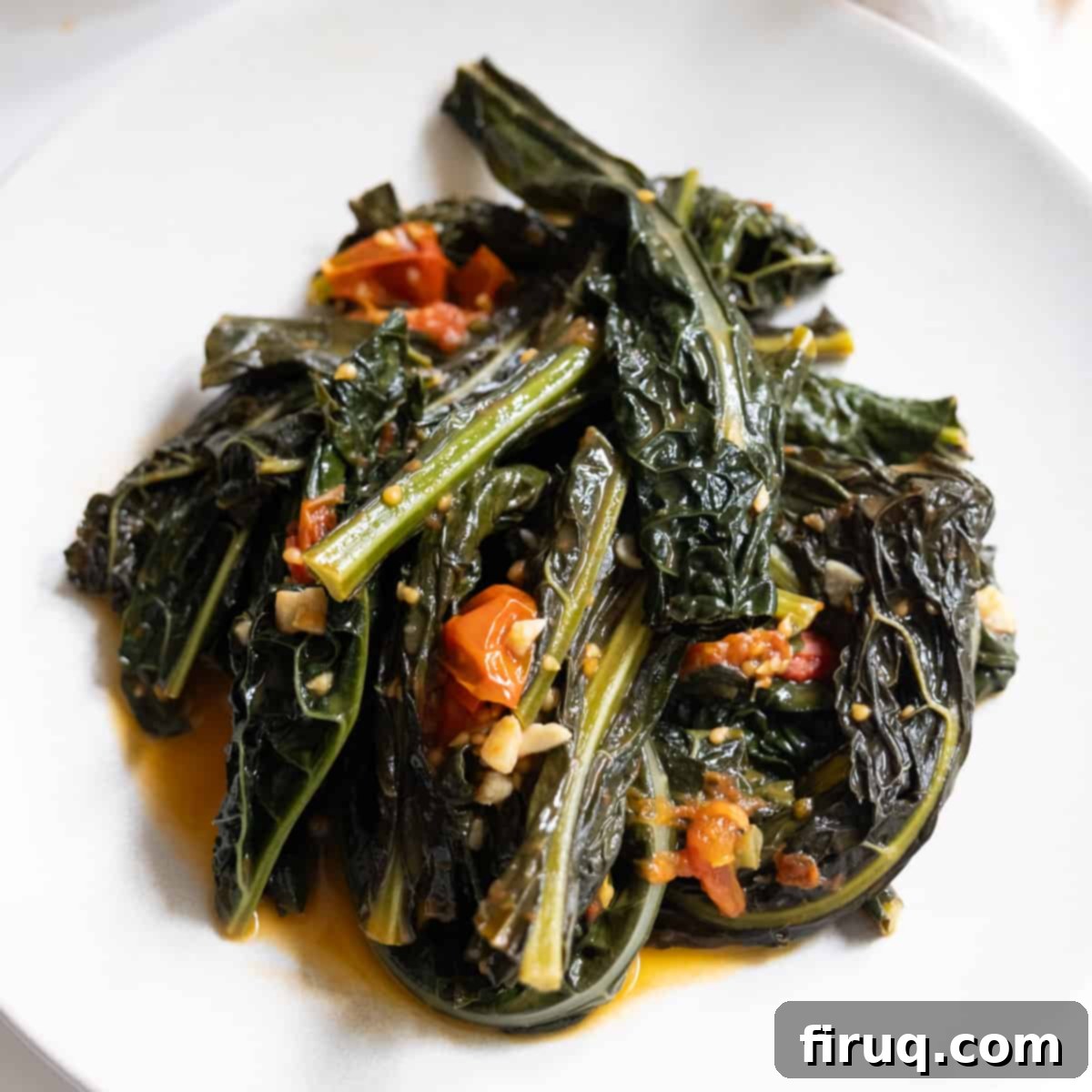Mastering Lacinato Kale: An Easy Braised Recipe with Lemon, Garlic & Tomatoes
Are you constantly searching for exciting and delicious vegetable side dishes? It can be a challenge to find options that are both nutritious and genuinely enjoyable, especially when it comes to greens. This Italian Lacinato kale recipe is here to change your perspective on cooking with kale. It’s not just delicious and incredibly easy to prepare, but it also uses simple, fresh ingredients you likely already have in your kitchen. We guarantee this vibrant, tender kale dish will become a beloved addition to your weeknight meal rotation, proving that healthy eating can be both convenient and bursting with flavor.
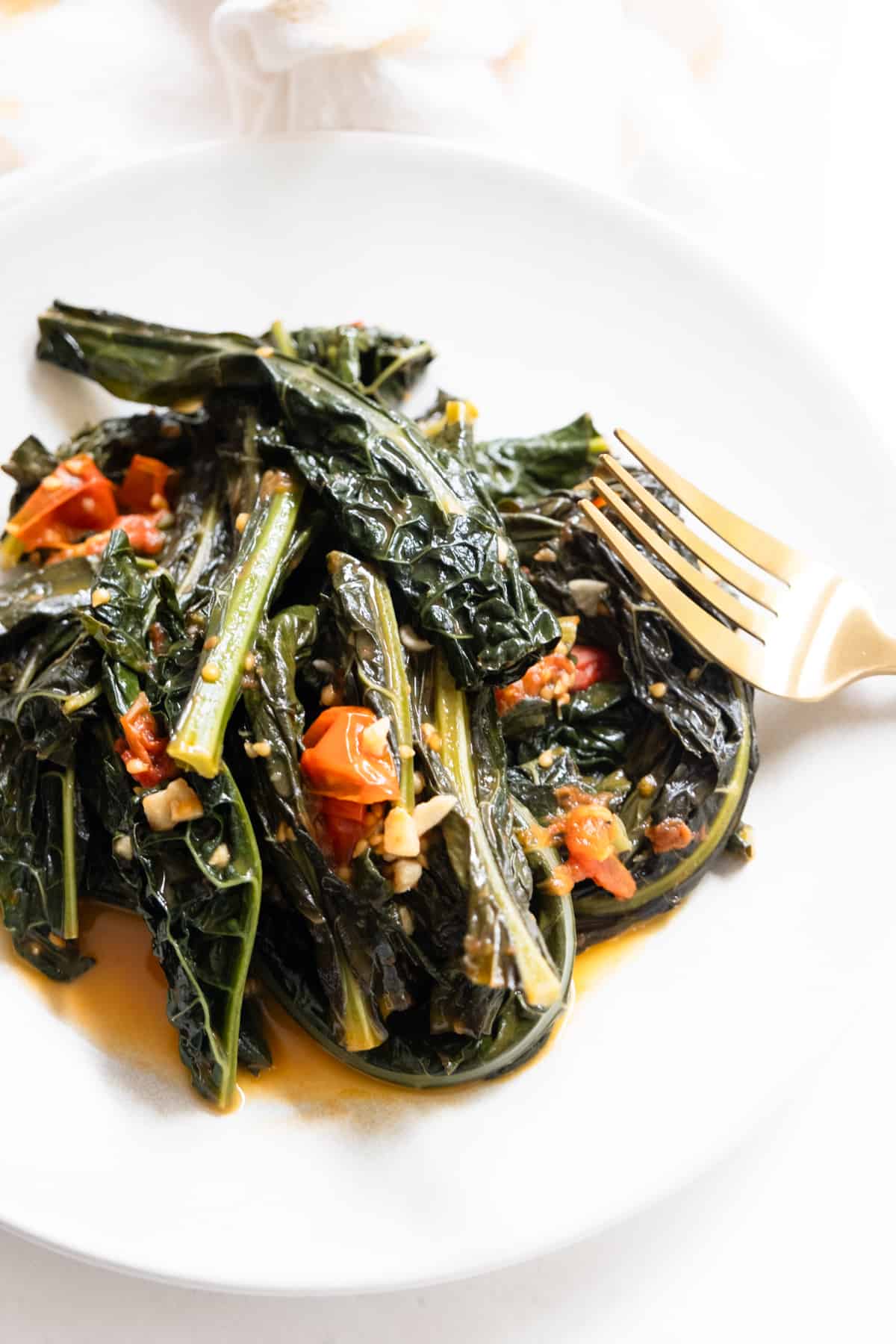
Let’s be honest: kale can be a tough sell. Despite its superfood status, many people find it dry, fibrous, and quite frankly, a texture nightmare if not prepared correctly. Health food enthusiasts and culinary trends have certainly put kale on the map, but perhaps haven’t always highlighted the best ways to make it truly enjoyable. The secret lies in the cooking method and choosing the right variety.
This recipe specifically calls for Lacinato kale, also known as Tuscan kale or dinosaur kale, because it is uniquely suited for braising. Unlike its curly counterpart, Lacinato kale holds its structure beautifully during the cooking process while softening into a melt-in-your-mouth tender texture that is truly palatable and enjoyable. When we combine it with the bright acidity of lemon, the aromatic warmth of garlic, and the sweet burst of cherry tomatoes, we create a side dish that’s not only incredibly flavorful but also surprisingly approachable. I even caught my son happily eating the tomatoes – a true testament to its deliciousness!
If you’re looking to expand your repertoire of delightful vegetable sides, be sure to check out some of our other favorites like Italian Cabbage with Pancetta or Marinated Eggplant and Onion. These dishes, much like our braised Lacinato kale, showcase how simple ingredients can be transformed into extraordinary flavors.
Ready to jump straight to the recipe? Use our handy guide below!
Jump to:
- What is Lacinato Kale?
- Where to Find It
- Ingredient Notes and Substitutions
- Step-by-Step Directions
- Pro Tip
- What to Serve It With
- Recipe FAQs
- Recipe Card
What is Lacinato Kale?
Lacinato kale is a distinct variety of kale, easily recognizable by its long, slender, dark blue-green leaves with a slightly wrinkled, bumpy texture. This unique appearance has earned it endearing nicknames such as Tuscan kale, Black Tuscan kale, or dinosaur kale. Its origins trace back to 18th-century Italy, where it was first cultivated, establishing its strong ties to traditional Italian cuisine.
Compared to the more common curly kale, Lacinato kale boasts a flavor profile that is notably more delicate and sweet, with earthy undertones. It lacks the intense bitterness often associated with other kale varieties, making it an excellent entry point for those who have previously been wary of kale. Its softer texture, even before cooking, makes it remarkably versatile, particularly shining in dishes where it’s braised or lightly sautéed. The leaves are sturdy enough to withstand cooking without disintegrating but tenderize beautifully to create a truly enjoyable eating experience.
Beyond its culinary appeal, Lacinato kale is a nutritional powerhouse. It’s packed with vitamins K, A, and C, as well as antioxidants and fiber, contributing to its superfood reputation. Incorporating this mild variety into your diet is a delicious way to boost your nutrient intake.
To keep your Lacinato kale fresh, store it in your fridge, ideally in a loose plastic bag. For extended freshness, especially if you won’t be using it within a day or two, I highly recommend wrapping the stems in a damp paper towel before placing it in the bag. This simple trick helps to maintain its moisture and crispness, ensuring it’s at its best when you’re ready to cook.
Where to Find Lacinato Kale
Finding Lacinato kale has become increasingly easier as its popularity grows. Most well-stocked grocery stores now carry a variety of kales, whether as bagged, pre-chopped greens or loose bunches. I often find the freshest and most vibrant Lacinato kale at local farmer’s markets, where it’s typically harvested closer to the sale date. This direct-from-farm sourcing often means superior flavor and texture.
When selecting Lacinato kale, look for deep, dark green leaves that are crisp and free from yellowing or wilting. The stems should be firm. While bagged kale can be convenient, I generally prefer to buy loose greens. This often indicates less processing and a shorter journey from the farm to your kitchen, resulting in a fresher product. While I’ve had success finding it at many supermarkets, I’ve noticed it’s less consistently available at places like Trader Joe’s, so it’s always good to check your local store’s produce section.
Ingredient Notes and Substitutions for Perfect Braised Kale
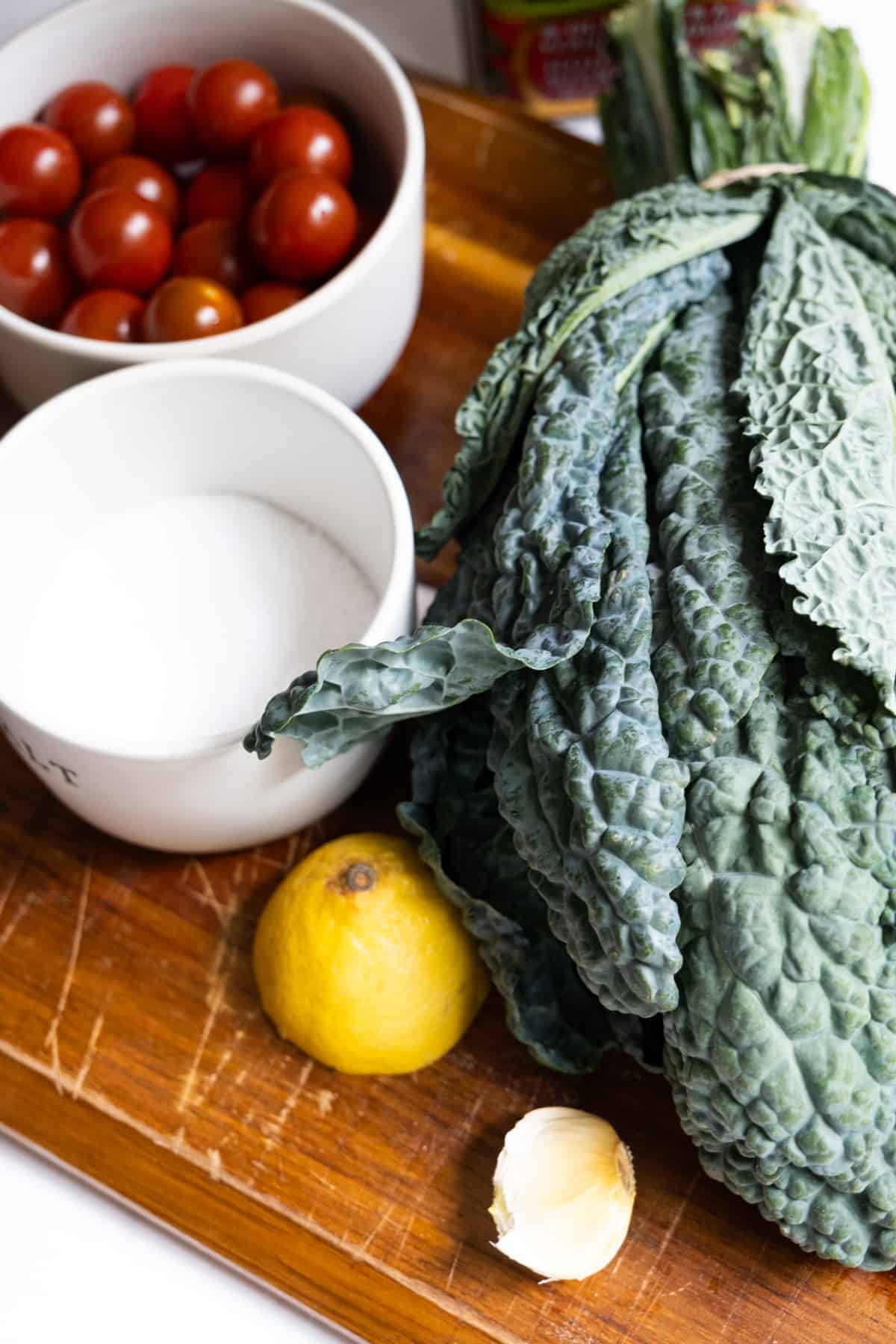
The success of this braised kale dish hinges on a few key ingredients and their thoughtful preparation. Here’s a closer look:
- Lacinato Kale: This is the star and not easily substituted for this specific recipe. It is crucial to use the Lacinato variety, also known as Tuscan kale or dinosaur kale, due to its unique texture and mild flavor. Its sturdy leaves hold up beautifully to braising, becoming tender and palatable without turning mushy or overly bitter. Other varieties like curly leaf kale or Red Russian kale are generally tougher and benefit more from massage (for salads) or prolonged cooking in soups, but they are NOT ideal for this quick braising method as they may remain fibrous.
- Water: We opt for plain water in this recipe because it acts as a neutral liquid, allowing the bright, delicate flavors of the cherry tomatoes and lemon to truly shine. Some recipes suggest using chicken broth, but in this instance, a strong broth could easily overpower the fresh, zesty notes we’re aiming for. Water ensures the natural essence of the vegetables and citrus is at the forefront.
- Cherry Tomatoes: It’s important to distinguish between cherry and grape tomatoes. While often used interchangeably, they possess distinct characteristics. Cherry tomatoes are typically rounder, juicier, and sweeter, with a thinner skin that breaks down delightfully when cooked, releasing a lovely sweet-tart liquid that forms part of our braising liquid. Grape tomatoes, on the other hand, are more oval, firmer, and less juicy, making them less ideal for creating the desired saucy consistency in this dish.
- Garlic: Freshly minced garlic is non-negotiable here. It forms the aromatic foundation of the dish, infusing the olive oil with its pungent, savory notes. Avoid pre-minced garlic if possible, as its flavor is often muted.
- Lemon: Fresh lemon juice is vital for adding a bright, acidic counterpoint to the earthy kale and sweet tomatoes. It lifts the flavors and adds a zesty finish. Always use fresh lemon over bottled juice for the best results.
- Olive Oil: A good quality extra virgin olive oil is preferred for sautéing the garlic and tomatoes. It contributes to the overall Mediterranean flavor profile and helps create a rich, glossy sauce.
- Butter: Added at the very end, a pat of cold butter is whisked into the sauce to emulsify it, adding incredible richness, body, and a beautiful sheen. This technique, known as Monter au Beurre, is a professional chef’s secret for enhancing sauces.
- Salt and Pepper: Simple seasonings are all that’s needed to enhance the natural flavors of these fresh ingredients. Adjust to taste.
Step-by-Step Directions for Braising Lacinato Kale
This recipe is designed for maximum flavor with minimum effort, making it incredibly quick and easy. The key to a smooth cooking process is to have all your ingredients prepared and ready to go before you start, a culinary practice known as “mise en place.”
Prep the Kale
Begin by thoroughly preparing your Lacinato kale. Rinse the leaves under cold running water to remove any dirt or grit, then pat them completely dry with paper towels. Excess water can dilute the flavors and prevent proper sautéing. Once dry, cut the kale leaves crosswise into roughly 1 to 1.5-inch wide strips, as shown in the picture below. This ensures even cooking and manageable bites.
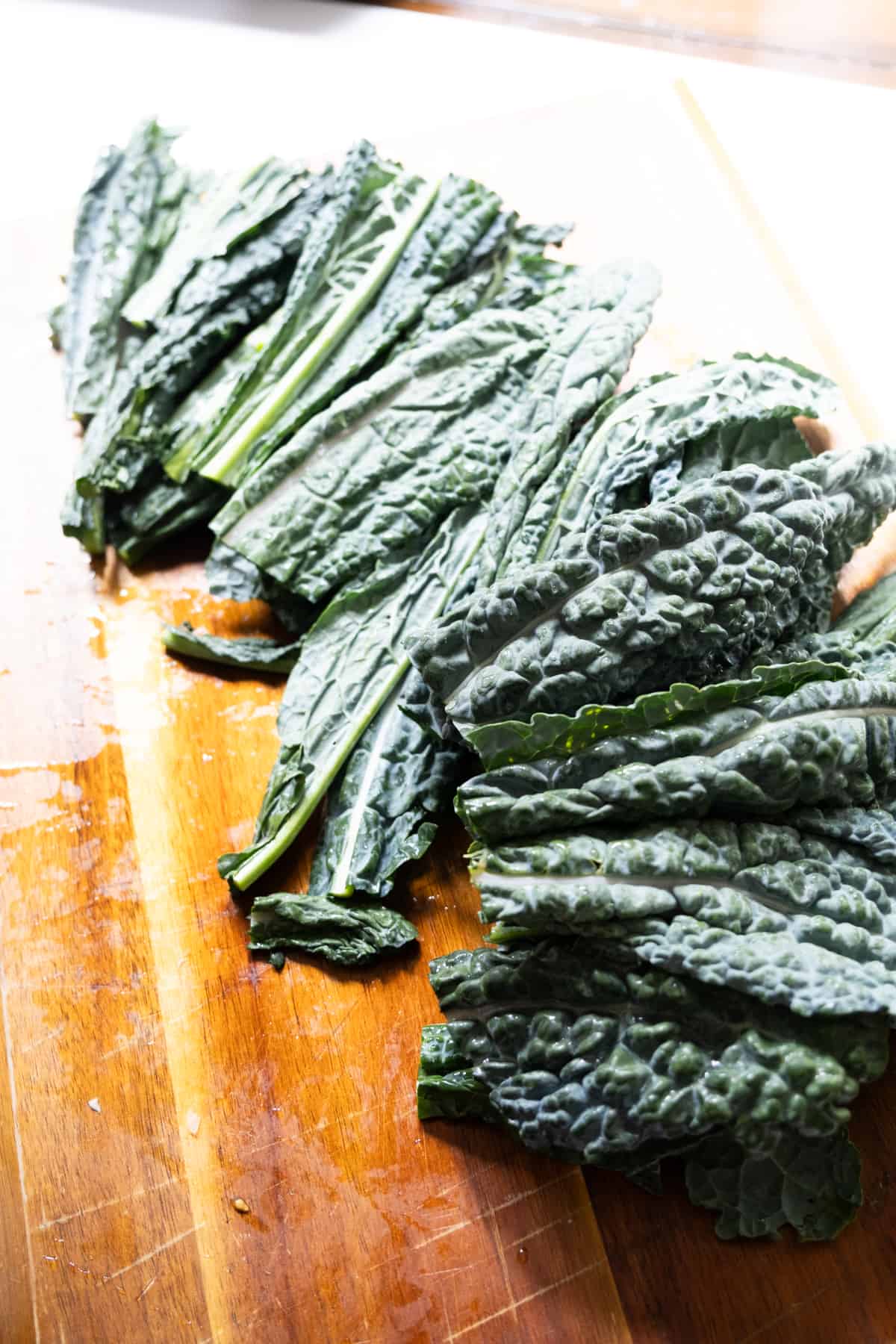
A note on safety: If you are serving this dish to small children or older adults, it would be safest to cut the kale into smaller, more manageable bite-sized pieces. As a Speech Pathologist specializing in swallowing disorders, I know that leafy greens can pose a choking hazard for individuals who may have difficulty chewing thoroughly or who tend to talk while eating. Always use your judgment and err on the side of caution when preparing food for vulnerable populations.
Sautéing the Aromatics and Tomatoes
In a sturdy Dutch oven or a large, heavy-bottomed pot, add your olive oil and place it over medium heat. Wait until the oil is shimmering, indicating it’s hot enough to add the garlic. Stir in the minced garlic and cook until it becomes wonderfully fragrant, which typically takes about 1 to 1.5 minutes. Watch closely to prevent it from burning; a little browning is fine, but you don’t want it to turn dark brown or crispy, as that can make it bitter.
Once you can unmistakably smell the garlic’s inviting aroma, add the halved cherry tomatoes to the pot. Immediately squeeze in the juice from a whole lemon. Stir everything together and cook, stirring occasionally, until the cherry tomatoes begin to slightly break down. This usually takes about 3 to 5 minutes, at which point they will release their sweet juices and start forming a light sauce. Season with salt and freshly ground black pepper to taste.
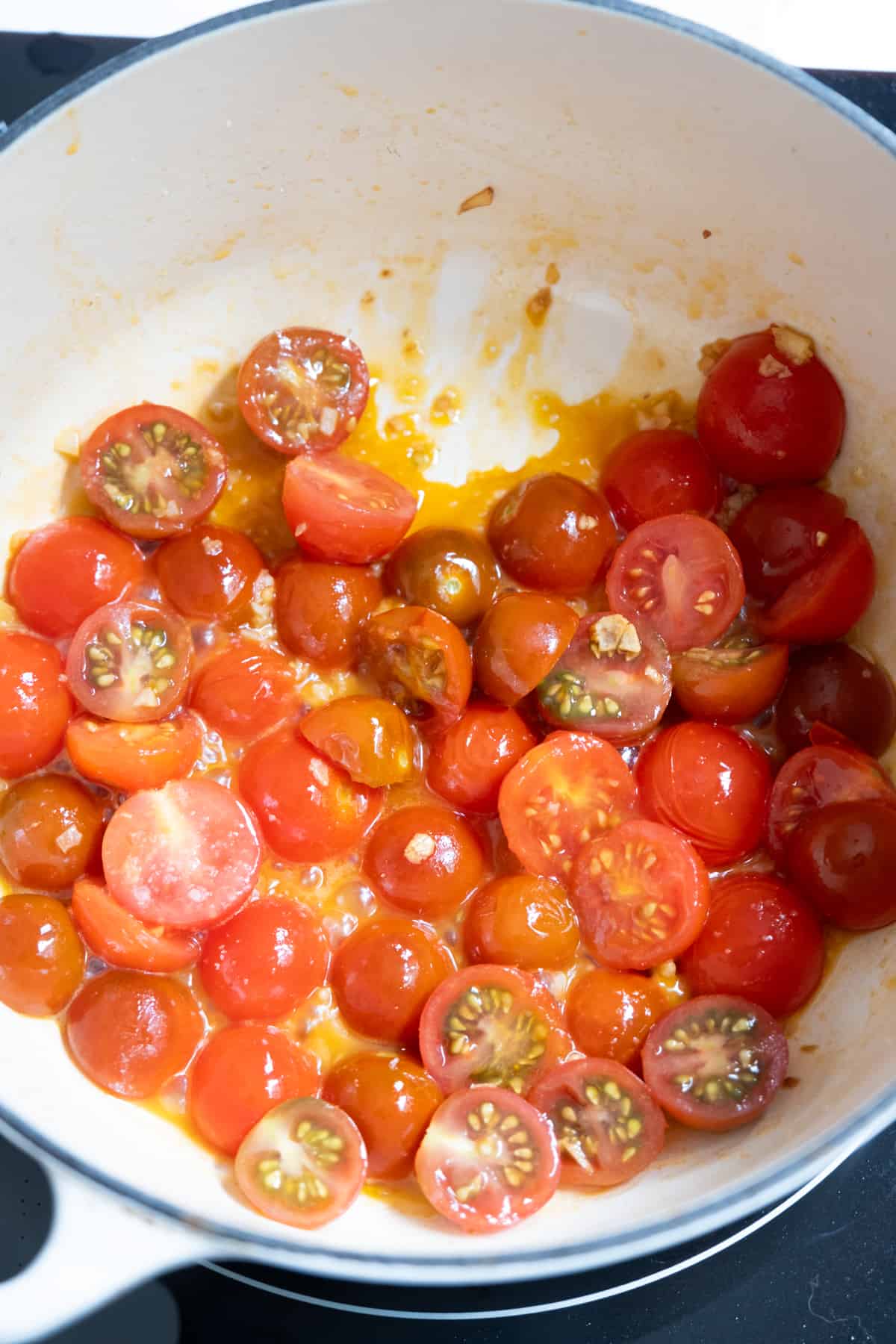
Braising the Kale to Perfection
Many kale recipes often instruct you to blanch the kale first, which involves an extra pot and an additional cooking step. This recipe is wonderfully streamlined because it eliminates that unnecessary process. As mentioned, Lacinato or dinosaur kale is perfect for braising; its tender nature means it doesn’t require blanching to achieve that desirable soft texture.
Once the cherry tomatoes have sufficiently broken down and formed a light sauce, it’s time to add the prepared kale. Add all the kale to the pot along with ¼ cup of water. Hold back the remaining ¼ cup of water for later. Cover the pot tightly and let the kale braise gently for 15 minutes. This slow, moist cooking method allows the kale to absorb the flavors while becoming incredibly tender. Remember to stir the kale once at the halfway point (around 7-8 minutes) to ensure even cooking and to check the liquid level.
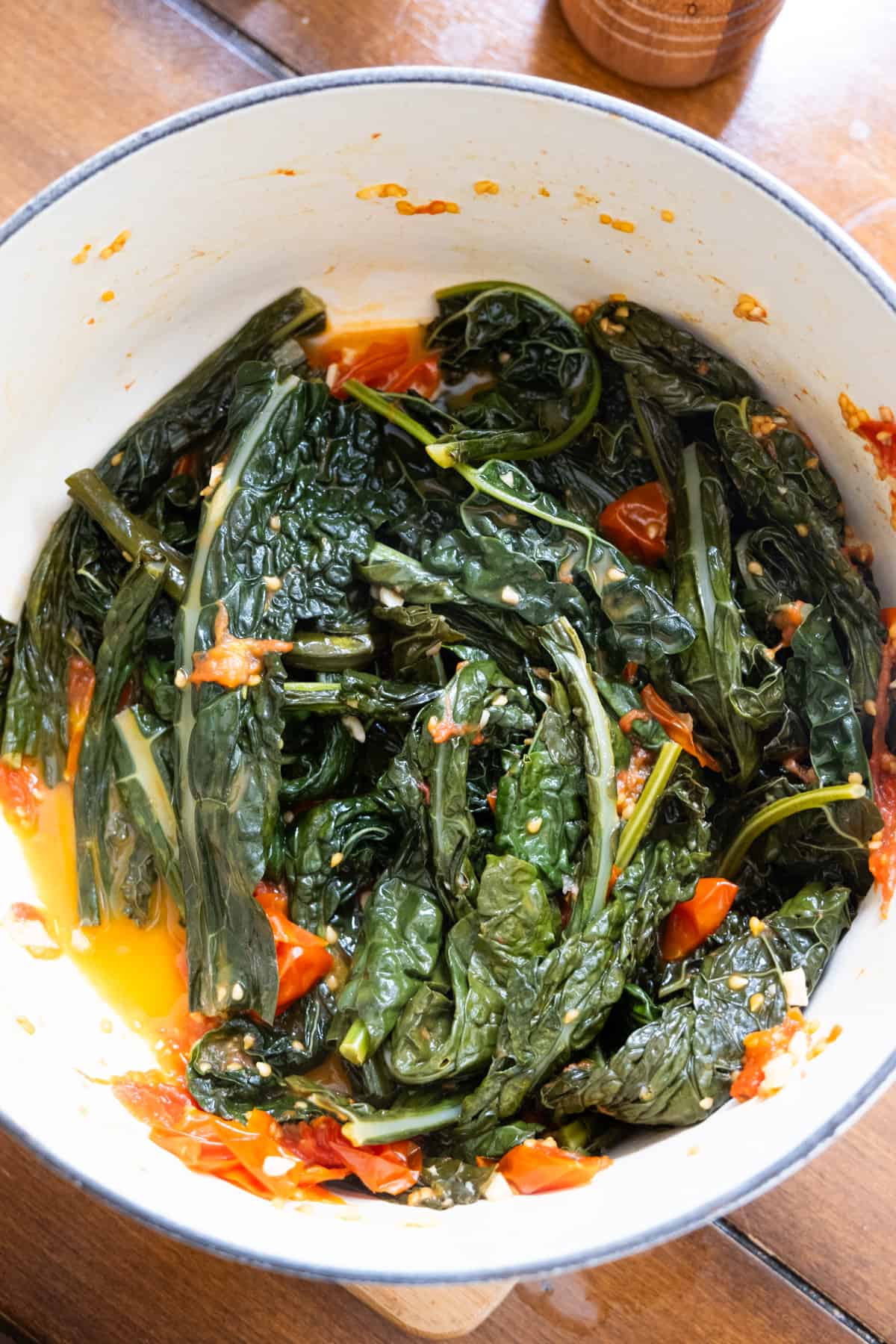
When you open the pot at the halfway mark to stir, take a moment to assess the liquid level. If the pot appears dry or there’s very little liquid remaining, this is the perfect time to add the reserved ¼ cup of water. This ensures the kale continues to braise gently and doesn’t scorch. Close the pot again and continue to braise for another 7-8 minutes, or until the kale is beautifully tender and cooked through.
Once the kale is tender, remove the Dutch oven from the heat. This is where the magic happens! Add the cold pat of butter to the hot kale and stir vigorously until it is completely melted and emulsified into the sauce. This finishing step, known as Monter au Beurre, will add a luscious richness and a beautiful glossy sheen to your dish. Serve your perfectly braised Lacinato kale immediately and enjoy!
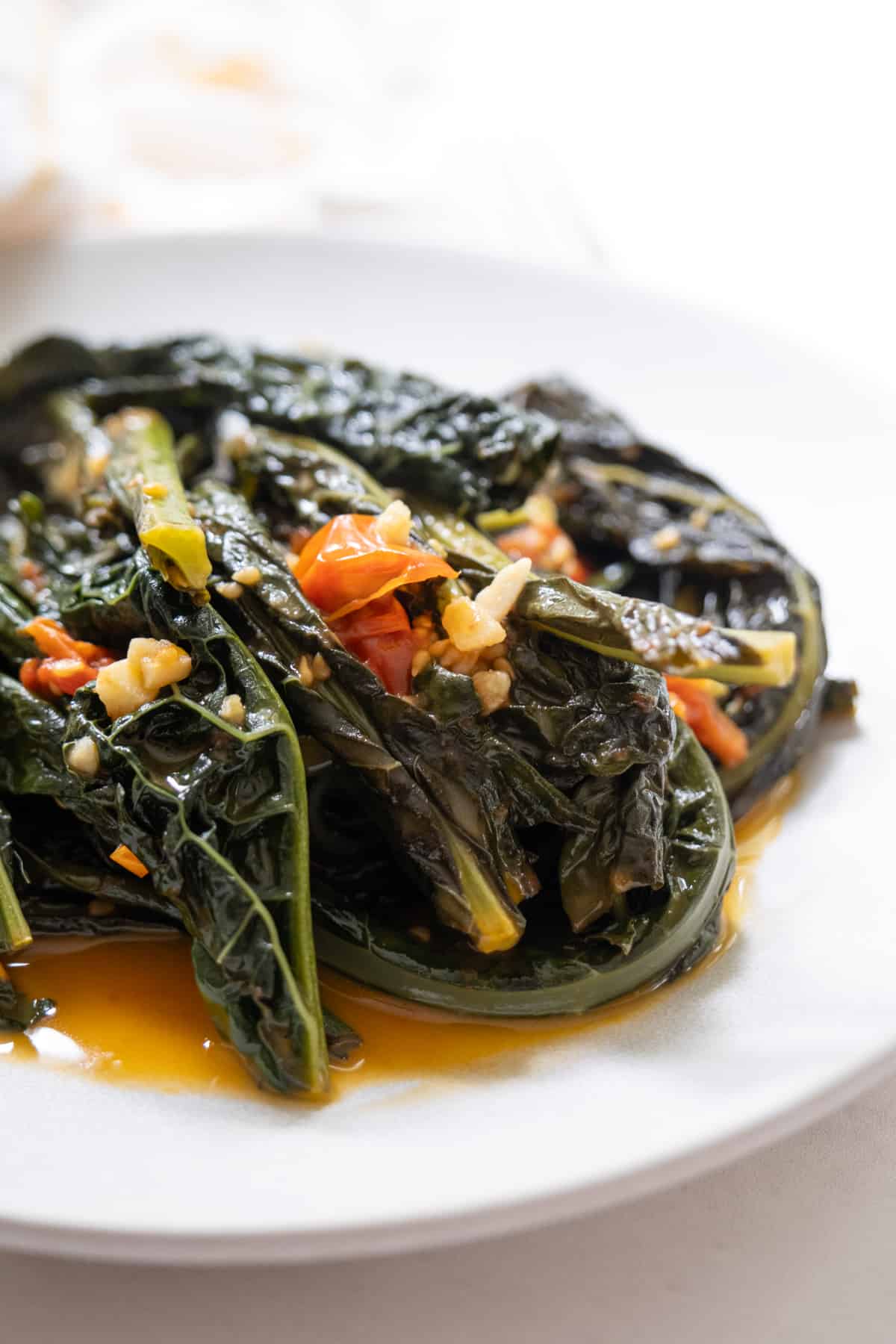
Pro Tip: The Secret to a Silky Sauce – Monter au Beurre
- Adding cold butter at the very end of this recipe is not just a suggestion; it’s the key to achieving a truly restaurant-quality finish and a deeper, more refined flavor! This technique, known as Monter au Beurre (a French phrase meaning “to mount with butter”), involves whisking cold butter into a hot sauce off the heat. The cold butter slowly melts and emulsifies with the liquid, creating a velvety smooth, slightly thickened sauce that clings beautifully to the kale. This process adds incredible shine, richness, and a luxurious mouthfeel without making the sauce greasy. You can clearly see in the “close up of lacinato kale cooked” image above how this final step transforms the sauce, giving it a glossy, inviting appearance. Don’t skip it!
What to Serve Braised Lacinato Kale With
This versatile braised Lacinato kale with lemon, garlic, and cherry tomatoes makes an outstanding side dish that pairs beautifully with a wide variety of main courses. Its bright, zesty, and savory profile complements rich meats and fresh seafood alike.
- This lacinato kale recipe goes swimmingly with seafood (pun intended!). The bright, acidic notes cut through the richness of fish and shellfish perfectly. Try serving it alongside some Pan-Seared Snapper, flavorful Steamed Mussels in White Wine, elegant Pistachio-Crusted Seabass, or perfectly seared Garlic Sage Seared Scallops!
- It’s also fantastic as a fresh, healthy counterpoint to heartier meals, especially in the summer. When we’re firing up the grill for burgers every weekend, this kale dish is a welcome way to get in some vegetables without sacrificing flavor. It would be great with our indulgent Bacon Blue Cheeseburger, the sophisticated Goat Cheese and Fig Jam Sliders, or the robust Big Fat Greek Chicken Burger!
- I absolutely LOVE a vibrant vegetable side alongside my big pasta meals. The freshness of the kale offers a wonderful contrast to rich sauces. Serve this with your comforting Sunday Sauce, hearty Bison Ragu, or an authentic Bolognese.
- If you’re looking to pair it with another meat, it’s a stellar choice. I’d serve it with tender Chicken Breast in Lemon Butter Sauce, crispy Italian Chicken Cutlets, flavorful Pesto Stuffed Chicken Breast, or savory Chevalatta!
- For a truly luxurious experience, serve it alongside one of our other favorites, The Creamiest Mushroom Truffle Risotto! The earthy notes of the risotto will sing with the bright kale.
Recipe FAQs
Absolutely, you can eat the stems of Lacinato kale! While they are tougher than the leaves, they are perfectly edible and nutritious. Just make sure to chop off the very end of the stem, which can be dry or woody. The stems can be finely chopped and added to the braising process a few minutes before the leaves, or they are excellent additions to homemade vegetable broths and soups. For a unique twist, you can even pan-fry them separately and serve them alongside beans or other legumes for added texture and nutrients.
In this recipe, blanching the Lacinato kale first is simply an unnecessary step and a waste of time and extra dishes. Lacinato kale is inherently more tender than other varieties, making it ideal for direct braising. The braising method in this recipe, which takes just 15 minutes, sufficiently tenderizes the kale while infusing it with all the delicious flavors of garlic, lemon, and cherry tomatoes. My philosophy is to keep cooking simple and efficient without compromising on taste or texture, and eliminating blanching perfectly aligns with that!
Storing and reheating this braised kale is quite straightforward. Allow any leftovers to cool completely, then transfer them to an airtight container and store in the refrigerator for up to 3-4 days. For reheating, while I’m usually a big proponent of gently warming dishes in a pan on the stovetop to preserve texture, I’ve found that this braised kale reheats perfectly well in the microwave. Simply place it in a microwave-safe dish, cover loosely, and heat in 30-second intervals, stirring in between, until warmed through. The flavors remain vibrant, and the kale stays tender.
Yes, absolutely! To make this braised Lacinato kale recipe vegan or dairy-free, simply omit the butter or substitute it with a plant-based butter alternative. The Monter au Beurre technique still works wonderfully with vegan butter, providing that same creamy finish and beautiful sheen. The rest of the ingredients are naturally vegan-friendly, ensuring a delicious and healthy plant-based side dish.
Some Favorite Healthier Meal Pairings
- Italian Cabbage Recipe
- Pasta Primavera with Broccoli and Asparagus
- Broccoli Rabe and Tortellini Soup
- Easy Chicken Cacciatore
Video How-To
📖 Recipe
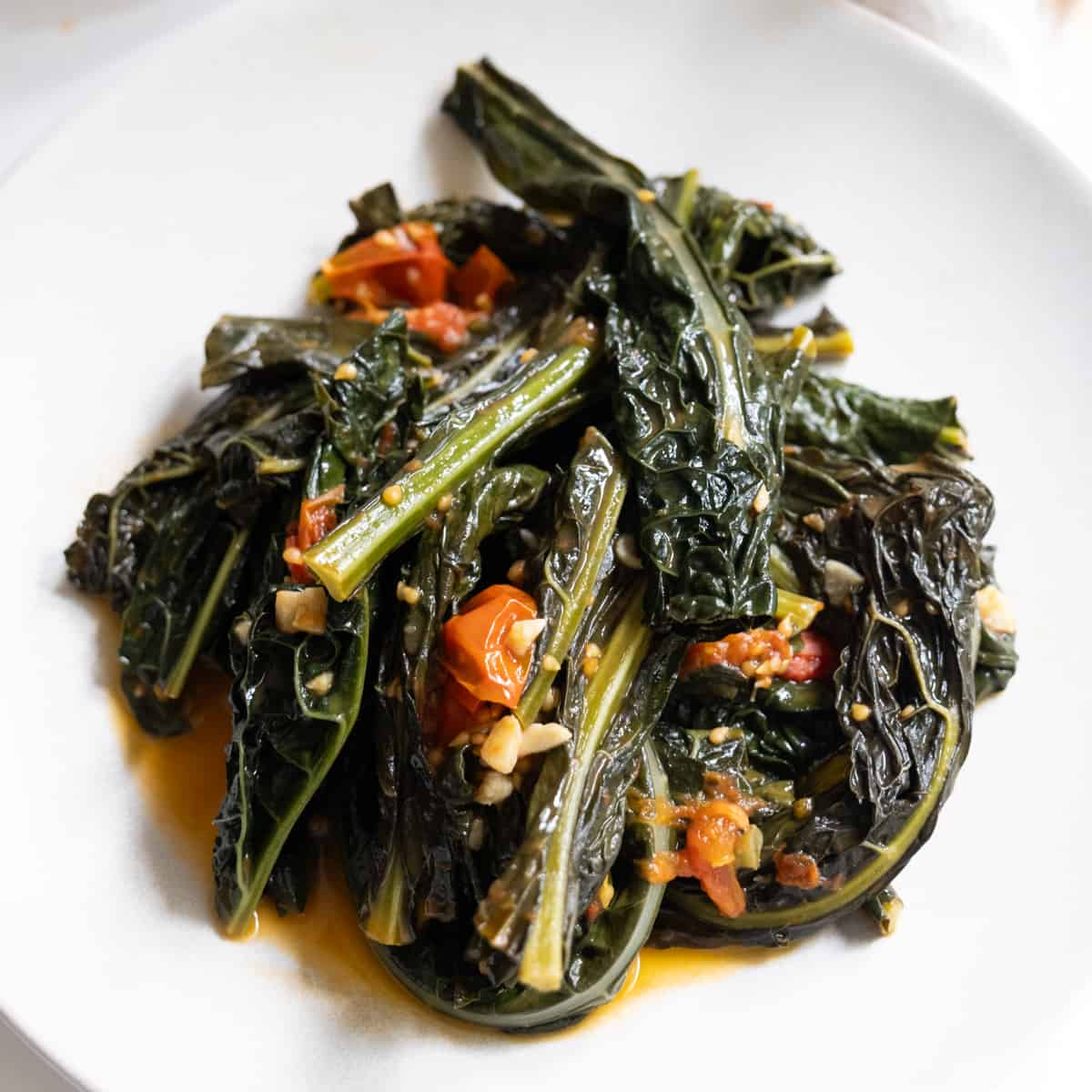
Italian Lacinato Kale Recipe (Tuscan)
Vincent DelGiudice
Pin Recipe
Equipment
-
dutch oven or pot
Ingredients
- 1 head lacinato kale
- 1 cup cherry tomatoes, halved
- 1 lemon
- 3 cloves garlic, minced
- ½ cup water
- 1 tablespoon cold butter (or vegan butter)
- 2 tablespoons extra virgin olive oil
- ½ teaspoon Salt (or to taste)
- ¼ teaspoon black pepper(or to taste)
Instructions
-
Prepare the vegetables: Rinse the Lacinato kale thoroughly in cold water and pat dry. Cut the kale crosswise into 1-1.5 inch strips. Halve the cherry tomatoes and mince the garlic.Sauté the aromatics: In a Dutch oven or large pot over medium heat, add the olive oil. Once shimmering, stir in the minced garlic and cook for about 1 to 1.5 minutes until fragrant, being careful not to burn it.Build the flavor base: Add the halved cherry tomatoes and the freshly squeezed juice from the whole lemon. Stir occasionally and cook for 3 to 5 minutes, or until the cherry tomatoes begin to slightly break down and release their juices. Season with salt and pepper to taste.
-
Braise the kale: Add the prepared kale and ¼ cup of water to the pot (reserve the remaining ¼ cup of water for later). Cover the pot tightly and let the kale braise for 15 minutes. At the halfway point (around 7-8 minutes), stir the kale. If the pot appears dry with very little liquid, add the remaining ¼ cup of water. Re-cover and continue braising until the kale is tender.
-
Finish and serve: Once the kale is tender, remove the Dutch oven from the heat. Add the cold pat of butter (or vegan butter) and stir vigorously until it is completely melted and emulsified into the sauce. This “Monter au Beurre” step adds richness and shine. Serve your delicious braised Lacinato kale immediately.
Notes

Nutrition
Tried this recipe?We’d love for you to Leave a Review!
We hope this enhanced Lacinato kale recipe inspires you to explore the delicious possibilities of this remarkable green. With its mild flavor, tender texture when braised, and the vibrant additions of lemon, garlic, and cherry tomatoes, it truly transcends the common perception of kale. This dish is not just a healthy choice, but a genuinely enjoyable one that will effortlessly elevate your weeknight meals and impress even the most skeptical eaters. Give it a try – you might just discover your new favorite vegetable side!
